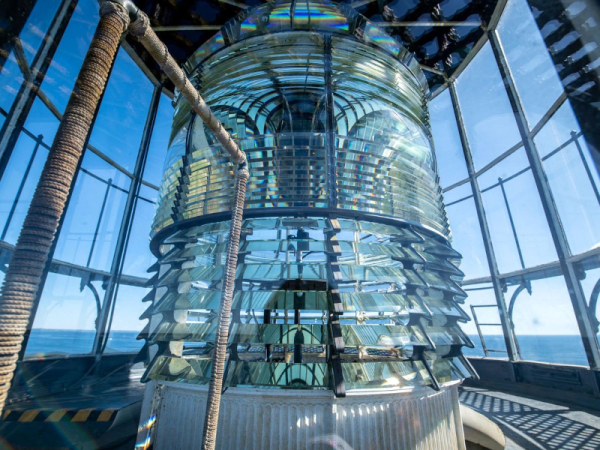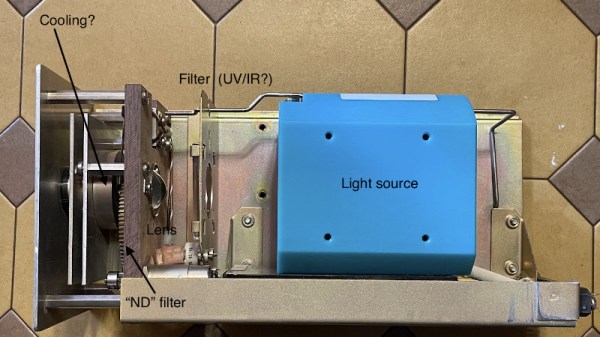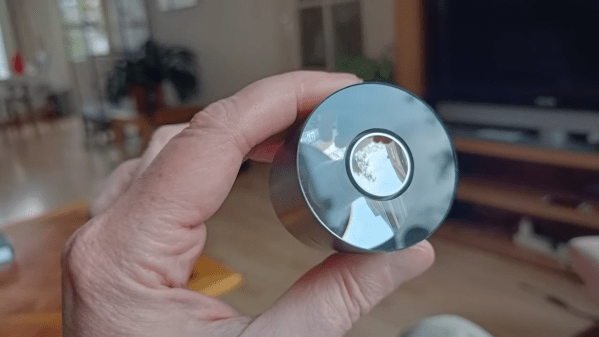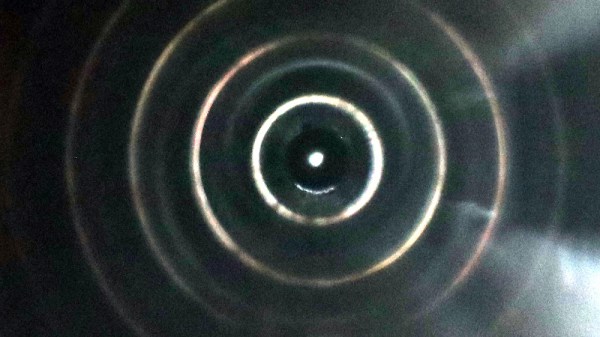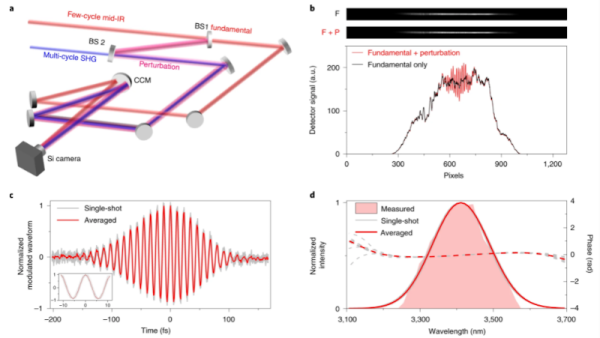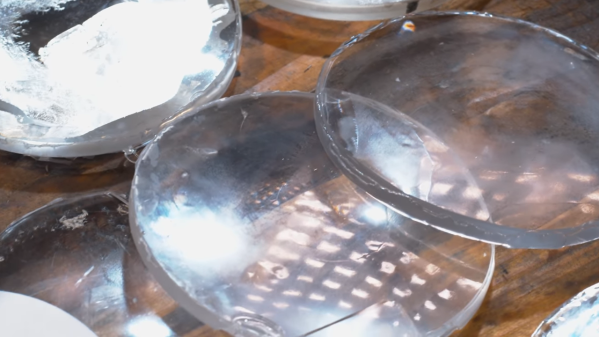Multiple people have recently shared this exciting demonstration (nitter) with us – visualizing airflow using a smartphone, called ‘background-oriented schlieren’. On a hot summer day, you might see waves in the air – caused by air changing density as it warms up, and therefore refracting the light differently. Schlieren photography is an general set of techniques for visualizing fluid flow, but of course, it can also be applied to airflow. In this case, using some clever optical recognition tricks, this schlieren method lets you visualize flow of air using only your Android smartphone’s high resolution camera and a known-pattern printed background! Continue reading “Observe Airflow Using Smartphone And Background-Oriented Schlieren”
optics83 Articles
The Origin Of The Fresnel Lens
If you are a Hackaday reader, you probably know what a Fresnel lens is. You find them in everything from overhead projectors to VR headsets. While it seems commonplace now, the Fresnel lens was an important invention for its day because it revolutionized maritime navigation and, according to a post over at IEEE Spectrum, that was the driving force behind its invention. In fact, the lens has been called “the invention that saved a million ships“.
The problem stems from issues in navigation. Navigating by the sun and the stars is fine, but not workable when you have heavy cloud cover, or other reasons you can’t see them. A lighthouse often marked an important point that you either wanted to navigate towards or, sometimes, away from. Sure, today, we have GPS, but for a long time, a lighthouse was your best bet.
An Illuminating Look At A Wolf 5151 Light Source
While originally designed to put light where the sun don’t shine for medical purposes, [Nava Whiteford] says the Wolf 5151 Xenon endoscopic light source also works well for microscopy and general optical experiments, especially since you can get them fairly cheap on the second hand market. His cost just $50 USD, which is a steal when you consider a replacement for its 300 watt Olympus-made bulb will run you about 200 bucks alone.
That said, [Nava] recently moved on to a more compact light source, and figured that was a good enough excuse to crack open the Wolf 5151 and see what makes it tick. In this particular post he’s just looking at the optical side of things, which is arguably the most interesting aspect of the device. Helpfully, the whole assembly is mounted to its own sled of sorts that can be pulled from the light source for a closer examination.
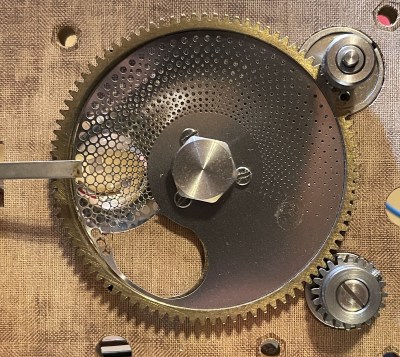
Beyond that expensive bulb we mentioned earlier, there’s a thick piece of what appears to be standard plate glass being used as an IR and UV filter. [Nava] suspects this component is responsible for keeping the rest of the optics from overheating, which is backed up by the fact that the metal plate its mounted to appears to feature a K-type thermocouple to keep an eye on its operating temperature. Forward of that is a unique aspheric lens that features a rough spot to presumably scatter the light at the center of the beam.
Our vote for the most fascinating component has to go to the Neutral Density (ND) filter, which is used to control the intensity of the light. In a more pedestrian light source you could just dim the bulb, but in this case, the Wolf 5151 uses a metal disk with an array of holes drilled into it. By rotating the disc with a DC motor, the lens can be variably occluded to reduce the amount of light that reaches the aperture, which connects to the fiber cable.
While it’s perhaps no surprise the build quality of this medical gear is considerably beyond the commercial gadgets most of us get to play with, it still doesn’t hold a candle (no pun intended) to the laser module pulled from a Tornado jet fighter.
Watch A Complete Reflector Telescope Machined From A Single Block Of Glass
If this is the easy part of making a complete reflector telescope from a single piece of glass, we can’t wait to get a load of the hard part!
A little backstory may be in order for those who don’t follow [Jeroen Vleggaar]’s Huygens Optics channel on YouTube. A few months ago, he released a video discussing monolithic telescopes, where all the reflective and refractive surfaces are ground into a single thick block of glass. Fellow optical engineer [Rik ter Horst] had built a few tiny monolithic Schmidt-Cassegrain reflectors for use in cube sats, so [Jeroen] decided to build a scaled-up version himself.
The build starts with a 45 mm thick block of crown glass, from which a 50 mm cylinder is bored with a diamond hole saw. The faces of the blank are then ground into complex curves to reflect incoming light, first off the parabolic rear surface and then onto the hyperbolic secondary mirror ground into the center of the front face. A final passage through a refracting surface in the center of the rear face completes the photons’ journey through the block of glass, squeezing a 275 mm focal length into a compact package.
All this, of course, vastly understates the work required to pull it off. Between the calculations needed to figure out the surface shapes in the first place to the steps taken to machine a famously unforgiving material like glass, every step is fraught with peril. And because the design is monolithic, any mistakes mean starting all over again. Check out the video below and marvel at the skills needed to get results like this.
What strikes us most about [Jeroen]’s videos is the mix of high-tech and age-old methods and materials used in making optics, which we’ve seen him put to use to make everything from tiny Tesla valves to variable-surface mirrors.
Continue reading “Watch A Complete Reflector Telescope Machined From A Single Block Of Glass”
The Light Guide Hiding In Your Extrusion
There should be a line of jokes that start “A physicist and an engineer walk into a bar…”. In my case I’m an engineer and my housemate is a physicist, so random conversations sometimes take interesting turns. Take the other day for example, as one does when talking she picked up a piece of aluminium extrusion that was sitting on our coffee table and turned it over in her hands. It has a hole down its centre and it’s natural to peer down it, at which point her attention was caught by the appearance of a series of concentric rings of light. Our conversation turned to the mechanism which might be causing this, and along the way took us into cameras, waveguides, and optical fibres.
The light reaching us after traveling along a straight narrow tube should at a cursory glance be traveling in a straight line, and indeed when I point the extrusion out of my window and look down it I can see a small segment of the tree in the distance I’ve pointed it at. It didn’t take us long to conclude that the concentric rings were successive reflections of the light coming into the end hole from off-centre angles.
In effect, the extrusion is a pinhole camera in which the image is projected onto the inside of a cylinder stretching away from the pinhole rather than onto a flat piece of film, and we were seeing the successive reflections of the resulting distorted image as they bounced to and fro down the tube towards us. It’s likely the imperfect mirror formed by the aluminium wall allowed us to see each image, as light was being diffused in our direction. Adding a piece of tape with a small pinhole at the end accentuated this effect, with the circles becoming much more sharply defined as the projected image became less blurry. Continue reading “The Light Guide Hiding In Your Extrusion”
Your Next Oscilloscope Might Be Optical
What’s better than a 100MHz scope? How about an optical one? Researchers at the University of Central Florida think that’s just the ticket, and they’ve built an oscilloscope that can measure the electric field of light. You can find the full paper online.
Reading the electrical field of light is difficult with traditional tools because of the very high frequency involved. According to [Michael Chini], who worked on the new instrument, the oscilloscope can be as much as 10,000 times faster as a conventional one.
The measurement of a few cycles of light requires some special techniques as you might expect. According to the paper:
[A]n intense fundamental pulse with a central wavelength of 3.4 µm creates charge packets in the pixels of a silicon-based image sensor via multiphoton excitation, leading to detectable photocurrents. The probability of excitation is perturbed by the field of a weak perturbation pulse, leading to a modulation in the excitation probability and therefore in the magnitude of the detected photocurrent. We have previously shown that, for collinear fundamental and perturbation pulses, the dependence of the modulation in the excitation probability on the time delay between the two pulses encodes the time-varying electric-field waveform of the laser pulse. Here, by using a crossed-beam geometry with cylindrical focusing, we map the time delay onto a transverse spatial coordinate of the image sensor chip to achieve single-shot detection.
Did you get that? In other words, instead of measuring the light pulse directly, they measure the change it makes on another known signal. We think…
Unless you’re moving high-speed data across fiber optic, we aren’t sure you really need this. However, the concept is intriguing and not previously unheard of. For example, we’ve seen capacitance meters that measure the change in frequency caused by adding an unknown capacitor into an existing oscillator.
If you want something more conventional, maybe look at some popular scopemeters. Of course, something this high speed might be able to apply time-domain reflectometry to fiber optics. Maybe.
The Ins And Outs Of Casting Lenses From Epoxy
If you need a lens for a project, chances are pretty good that you pick up a catalog or look up an optics vendor online and just order something. Practical, no doubt, but pretty unsporting, especially when it’s possible to cast custom lenses at home using silicone molds and epoxy resins.
Possible, but not exactly easy, as [Zachary Tong] relates. His journey into custom DIY optics began while looking for ways to make copies of existing mirrors using carbon fiber and resin, using the technique of replication molding. While playing with that, he realized that an inexpensive glass or plastic lens could stand in for the precision-machined metal mandrel which is usually used in this technique. Pretty soon he was using silicone rubber to make two-piece, high-quality molds of lenses, good enough to try a few casting shots with epoxy resin. [Zach] ran into a few problems along the way, like proper resin selection, temperature control, mold release agent compatibility, and even dealing with shrinkage in both the mold material and the resin. But he’s had some pretty good results, which he shares in the video below.
[Zach] is clear that this isn’t really a tutorial, but rather a summary of the highs and lows he experienced while he was working on these casting methods. It’s not his first time casting lenses, of course, and we doubt it’ll be his last — something tells us he won’t be able to resist trying this all-liquid lens casting method in his lab.
Continue reading “The Ins And Outs Of Casting Lenses From Epoxy”


